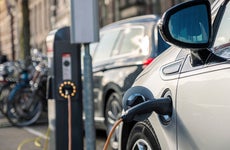10 Facts about electric cars

The Bankrate promise
At Bankrate, we strive to help you make smarter financial decisions. To help readers understand how insurance affects their finances, we have licensed insurance professionals on staff who have spent a combined 47 years in the auto, home and life insurance industries. While we adhere to strict , this post may contain references to products from our partners. Here's an explanation of . Our content is backed by Coverage.com, LLC, a licensed entity (NPN: 19966249). For more information, please see our .
Demand for electric vehicles, commonly referred to as EVs, is increasing substantially and is pacing to reach record levels in 2023 according to the International Energy Agency (IEA), expanding to account for around one-fifth of the overall car market. More than 10 million electric cars were sold globally in 2022, and that figure is expected to grow to 14 percent before the close of 2023.
There’s a growing diversity of electric cars on the market. While Tesla has been one of the leaders in the EV space, automakers are adding new electric options to their lineup every year. Between 2023 and 2025, a long list of new electric vehicles are expected to hit the market from car brands such as Alfa Romeo, Bentley and even Apple (yes, the tech company). Bankrate breaks down the facts about electric cars, weighs the pros and cons of electric cars and discusses how they work.
Electric cars in 2023
- Electric cars’ share of the car market has increased from 4 percent in 2020 to 14 percent in 2022. (IEA)
- There are more than 130,000 public EV charging stations across the country. (White House)
- In March 2023, San Francisco became the first-ever major metropolitan city where half of all new vehicle registrations were electric vehicles. (S&P Global Mobility)
- There are 26 million EVs on the road globally. (IEA)
- There are more than 3 million EVs on the road in the U.S. (White House)
- Nearly 300,000 new full battery-electric vehicles were sold in the U.S. during the second quarter of 2023 — an increase of 48.4 percent of the same quarter in 2022. (Cox Automotive)
Various significant developments are pushing EVs into the forefront of the car market. As more electric cars are produced, the cost to produce batteries has dropped, making EVs more affordable. Increased competition among EV manufacturers and government incentives for the production of EVs are also helping to drive down prices and making EV purchases more attractive to consumers. In fact, a tipping point may be reached in 2023, when the price of EVs are on par, if not cheaper, than cars with traditional internal combustion engines. That’s a huge step forward for the EV market.
At the same time, the number of charging stations across the country continues to multiply. Since 2021, the number of charging stations in the United States has grown by about 40 percent. California leads the country with 14,979 stations, according to the U.D. Department of Energy. New York holds the next highest number of chargers, where there were 3,529 at last count.
Meanwhile, more than 10 million electric vehicles were sold globally in 2022 and that figure is expected to increase by 35 percent to reach 14 million before 2024. Electric vehicle sales growth continued at a record pace in 2022 even amid global supply chain issues and various other pressures that impacted the market.
Key electric car facts
Electric vehicles are not a passing trend; they become more affordable each year and consumers are becoming more comfortable with the idea of plugging in instead of fueling up. A recent survey by Consumer Reports found that more than one-third of Americans would “definitely” or “seriously consider buying an electric vehicle if they were to purchase a new car today. Other interesting electric car facts include:
- The first electric vehicle was created in 1832. (Energy.gov)
- An EV would cost only $1.22 in energy to travel the same distance as a gallon of gas, which currently averages $3.83. (Energy.gov, AAA)
- A Tesla Roadster is faster than most sports cars, with an acceleration speed of 0 to 60 in 1.9 seconds. To compare, a Ferrari or Lamborghini accelerates from 0 to 62 in 2.8 to 2.9 seconds. (Tesla and Auto Express)
- The majority of EV car sales are in three markets: China, Europe and the United States. China leads the way with 60 percent of EV car sales globally. (IEA)
- EV car usage is on target to avoid the use of 5 million barrels of oil per day by 2030 (IEA)
- 77 percent of people who want to purchase an electric vehicle cite saving money on gas as the primary reason. (AAA)
- 50 percent of adults in the U.S. say they are not too or not at all likely to consider purchasing an EV. (Pew Research Center)
- 60 percent of consumers avoid EVs because they worry there are not enough places to charge. (AAA)
- Many new EVs can take up to 12 hours to charge if using a Level 2 outlet. (Kelley Blue Book)
- Tesla sold the most battery-electric vehicles worldwide as of 2022. (CleanTechnica)
What is an electric car?
An electric car is one that is either powered by an electric motor that solely draws energy from a rechargeable battery or powered by both an electric motor and an internal combustion engine (a hybrid EV). An EV’s battery is charged using an external power source at home or an EV charging station.
Most popular EVs
Five manufacturers make up more than 50 percent of non-hybrid battery-operated electric vehicle sales worldwide. According to CleanTechnica, the most popular EV manufacturers globally as of 2022 are:
- Tesla
- BYD
- SAIC Motor
- Volkswagen Group
- Geely-Volvo
Types of electric cars
Electric cars come in three main types:
- Hybrid electric vehicles (HEVs): HEVs combine a gas-powered engine with one (or more) electric motors. An HEV does not plug in; it collects energy through regenerative braking. The Toyota Prius may be one of the best-known HEVs.
- Plug-in hybrid electric vehicles (PHEVs): Similar to an HEV, the main difference is that a PHEV is able to plug in to charge. The Prius also comes as a plug-in version.
- Battery electric vehicles (BEVs): Also known as an all-electric car, BEVs needs to be plugged in to recharge. Teslas are BEVs.
How do electric cars work?
An electric vehicle works similarly to a gas-powered car. However, EV drivers may spot some differences from gas-powered vehicles, such as:
- Quiet operation: Many passersby often get startled and say they did not hear an EV approaching, and first-time owners say they are sometimes unsure if their car is on.
- Sluggish acceleration: Some hybrid EVs are designed to accelerate slowly and coast, which takes some getting used to. However, electric plug-ins such as the Tesla or Porsche EVs, are very fast.
- Marked deceleration: EVs typically take advantage of regenerative braking to recharge the battery. Letting off the accelerator could cause the car to noticeably slow down more than a regular vehicle.
- Extra trunk or “frunk” space: Pure EVs don’t have a combustible engine. Therefore, the front hood is empty and, in many models, used as a front trunk.
What powers electric cars?
EVs use batteries to power the vehicle. A traction battery pack drives the vehicle’s wheels. You will find that some cars use electric motor-generators that work to drive the EV and regenerate the battery.
Pros and cons of electric cars
Electric vehicles have come a long way in the last few years, but still have much more room for improvement. In addition to the electric car facts already covered, consider the following benefits and drawbacks.
Pros
- Energy-efficient: EVs directly convert more than 85 percent of electrical energy into motion, compared to internal combustion engines, which convert less than 40 percent.
- Lower maintenance costs: EVs do not have an engine that needs maintenance or oil replacement. And in the case of pure-electric vehicles, brake use is minimal due to the regenerative braking that automatically slows the car down when you let your foot off the accelerator.
- Smaller environmental impact: EVs do not emit pollutants from tailpipes and do not require as much (or sometimes any) gasoline.
Cons
- Cost: While electric cars have become much cheaper, they are still more expensive than gasoline-powered vehicles. At the end of 2022, the average new car cost $49,507, while an average EV was $61,448, according to Kelley Blue Book.
- Range: According to Energy.gov, electric vehicles can only travel 260 to 400 miles on one charge, depending on the model.
- Charging: Charging an EV takes much longer than filling up a car with fuel. Charging a new electric vehicle can take up to 12 hours using a Level 2 charger, although Tesla Superchargers can charge Teslas in as little as 15 minutes.
How much do electric cars cost?
Many factors affect the cost of owning and driving an electric vehicle. Compare the price of driving a gas-powered car to an EV, and you will see some balance between the savings and higher costs of owning an EV.
| Average Cost | Gas Vehicle | Electric Vehicle |
|---|---|---|
| Fuel/energy | $3.83 | $1.22 |
| Purchase price | $49,507 | $61,448 |
| Annual avg. for full coverage car insurance | $2,014 | $2,014 |
| Annual avg. cost of vehicle ownership | $10,728 | $4,600 |
Technology and infrastructure advancements are making EVs an excellent alternative to gas-powered cars. You could eliminate your gas bill and become part of the sustainable movement. Best of all, driving an EV does not mean you compromise performance or fun — many models are well-equipped to drive as comfortably and capably as a traditional combustion vehicle.
How much does it cost to insure an electric car?
In addition to knowing the key electric cars facts covered above, car insurance is another major consideration related to EVs. While you will often pay more to insure an electric vehicle compared to a gas vehicle, that’s not always the case. The average cost of insurance for an electric vehicle is about the same as a gas vehicle at $2,014 annually for full coverage. However, for some electric vehicles, such as the Tesla Model X, the cost can be as steep as $4,364 annually for full coverage. The higher cost of insuring electric vehicles is due primarily to their higher retail sales price.
Insurance costs vary depending on the type of electric vehicle you purchase. For instance, it is far cheaper to insure a Chevy Bolt, on average, at $2,007 annually than it is to insure the Tesla Model X. Some insurance companies even offer an EV discount, although this is not a common offering. You may save more on your EV car insurance with discounts for bundling multiple policies with one company and opting for such features as paperless billing.
Related Articles



